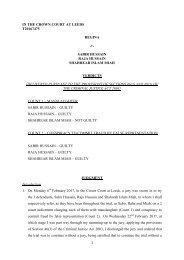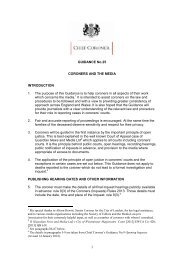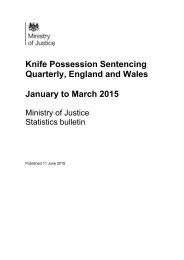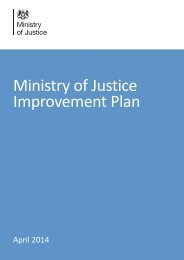HMP Doncaster
Doncaster-web-2015
Doncaster-web-2015
You also want an ePaper? Increase the reach of your titles
YUMPU automatically turns print PDFs into web optimized ePapers that Google loves.
Section 1. Safety<br />
Self-harm and suicide prevention<br />
Expected outcomes:<br />
The prison provides a safe and secure environment which reduces the risk of self-harm<br />
and suicide. Prisoners are identified at an early stage and given the necessary support.<br />
All staff are aware of and alert to vulnerability issues, are appropriately trained and have<br />
access to proper equipment and support.<br />
1.21 The incidence of self-harm was very high. There had been three self-inflicted deaths in the previous<br />
18 months, but important recommendations following these deaths had not been implemented or<br />
followed up. Some prisoners at risk of self-harm were isolated in poor conditions with insufficient<br />
activities, staff did not always have time to care for them, and case management processes were<br />
poor. There was a new Listener scheme, but prisoner access was currently limited. The segregation<br />
unit constant watch cells were wholly inappropriate for people in crisis.<br />
1.22 In our survey, 44% of prisoners said they had emotional well-being or mental health<br />
problems. The incidence of self-harm was very high compared with similar prisons, with 329<br />
incidents in the previous six months, involving 236 prisoners. There were 55 at-risk<br />
prisoners subject to assessment, care in custody and teamwork (ACCT) case management<br />
and one on constant watch during the inspection. There has been 534 ACCTs opened in the<br />
previous six months.<br />
1.23 There had been 11 deaths in custody since the last inspection, three of which were selfinflicted.<br />
The prison had not effectively implemented some key recommendations made by<br />
the Prisons and Probation Ombudsman (PPO) following its reports into these deaths, such as<br />
implementing effective ACCT care planning (see main recommendation S40).<br />
1.24 Around three-quarters of staff had current ACCT training, which was a big increase since<br />
the last inspection, but training for the remainder was still required. ACCT documentation<br />
was completed but not always sufficiently promptly, and information on triggers and the<br />
quality of care maps were poor. Reviews were not always sufficiently multidisciplinary, and<br />
mental health staff were not always present at case reviews where mental health was a<br />
primary factor. Activity sessions aimed specifically at prisoners on ACCTs were a positive<br />
initiative but not enough was done to encourage them to attend. Many prisoners at risk of<br />
self-harm were isolated in poor conditions, and locked in their cells for long periods with<br />
insufficient activities. They told us that staff were caring, but had little time to talk to them<br />
(see main recommendation S40).<br />
1.25 Buddies (see also paragraph 1.6) provided some good support to prisoners, and there was<br />
now a new Listener scheme (prisoners trained by the Samaritans to provide confidential<br />
emotional support to fellow prisoners). However, prisoner access to Listeners was<br />
sometimes hindered, particularly at night, due to lack of staff to escort them to units (see<br />
main recommendation S40). There were two care suites, which had been used on 66 nights<br />
in the previous six months, and further care suites were being developed for Listener use.<br />
1.26 From January to June 2015, 60 prisoners on ACCTs had been held in the segregation unit<br />
(see paragraph 1.56). Two constant watch cells on the unit had been used 22 times for 11<br />
prisoners in the previous six months. During the inspection, one was occupied by a prisoner<br />
who had been on and off constant watch since May 2015, and who was awaiting a transfer to<br />
a secure hospital. The cells were wholly inappropriate for people in crisis; they were stark<br />
and grubby, and the plastic-covered doors inhibited communication with health care staff<br />
undertaking the watch.<br />
22 <strong>HMP</strong> <strong>Doncaster</strong>












